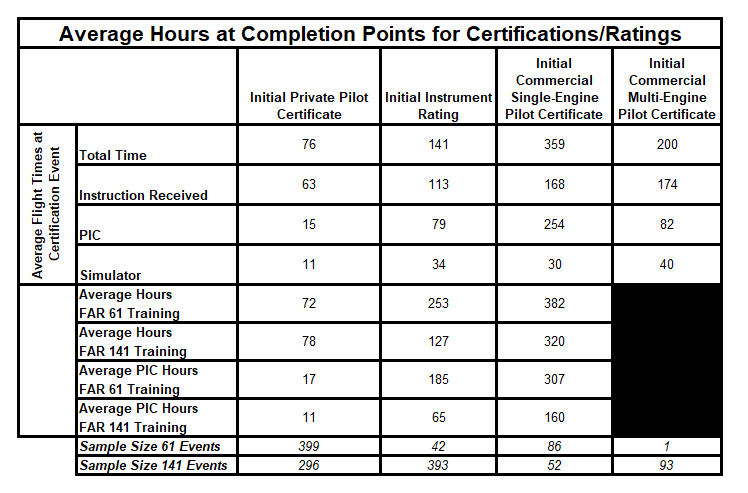A few years ago I went back through a bunch of practical tests I had given and came up with some averages of how many hours people had when they completed practical tests. With a couple more years of tests completed, I figured was time to update the sample size and see where the data falls with more input.
The goal was to answer the question, how many hours does a pilot typically have when they complete a private or commercial pilot certificate and instrument rating? So, I compiled hours for each event from each practical test I have given through the end of 2023 and this is what I found.
Private pilots have an average of 76 hours when they complete their certificate.
While the FAA minimum is 40 hours (less potentially in an FAA-approved 141 program), few actually complete their certification at that low of hours. Most take a few more hours.
I then broke down the difference between those who completed their training in a 141 program versus in more traditional 61 pilot training.
78 Hours were the average for 141 private pilots; and
72 Hours were the average for 61 private pilots
When it came to instrument ratings, the numbers flipped.
Instrument pilots too an average of 141 hours to get to the completion of an instrument rating.
In this case, those who completed their instrument ratings in 141 programs did so on average with significantly fewer hours.
127 Hours were the average for 141 instrument ratings; and
253 Hours were the average for 61 instrument ratings
When it came to initial commercial pilot certifications, the 141 pilots again had feweer hours on average than those who complete their certifications under part 61 training.
320 Hours were the average for 141 initial commercial single-engine certificates; and
382 Hours were the average for 61 initial commercial single-engine certificates
A more specific example related to initial commercial pilot certificates issued for applicants who completed a multi-engine commercial certificate as their initial commercial certification. All but one of my sample size did this in a 141 training program.
Applicants for initial commercial mult-engine certificates did so at an average of 200 total hours of flight time.
This is an example of how 141 programs do shine and end up having the products of their training complete their initial commercial pilot certification at significantly lower hours than the total 250 hours that would be required for pilots who do not complete their training in a 141 program. This allows them to then proceed from this point frequently to an added commercial single-engine certification and on to a CFI certificate after that.
There are a few other points of data here that I collected that may be of some interest, relating to how much PIC time, how much total instrument time, how much simulator time, or even how much overall instruction was received for students on average and broken down between students in 141 versus 61 training programs. Feel free to dig through the data points here and see what you find interesting.
I can’t say that this data is an example of what happens everywhere, but with a general sample size and a variety of locations where I provide tests, I thought it was at least an interesting set of data to share.
You may be reading this and thinking about how you compare to these numbers. Whether you have more or less hours than these average. But in the end, does it really matter?
It isn’t about the hours, it is about when you were proficient and had the knowledge, skills, and risk management abilities to meet the requirements for the particular certificate or rating. Plus, if you are doing the training for a career path goal, they are all hours that count toward that eventual ATP certificate anyway. And that one requires a few more hours on top of these.


that’s some really interesting data…..the most surprising to me was the Pvt. numbers…I would not have guessed Part 61 applicatants to be faster…
I do wonder if the later ratings in the 141 environment come quicker becase those students spend more time in a structrued enviroment (like a university) and plow through the ratings – rather just Part 61 folks – who may be going at a slower pace….
But still – thanks for this….
I very much think that the structure of the training in the 141 gets them to the upper certificates at lower hours. In a sense, it really doesn’t matter if a person gets their private in 40 or 80 hours, if they are going through a sequency of training. It matters what the training includes and how efficient it is to get them to the end goal, not necessarily just the steps along the way at an arbitrary point.
i’m curious to know what the age group breakdown is for those who earn their initial private pilot certificate
A good question!…I can say anecdotally that they are generally 20-28 years old for general range of the majority of my applicants. Most are doing the training career bound.